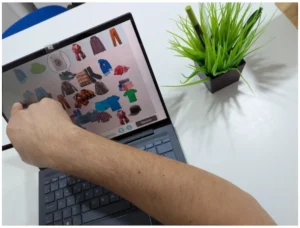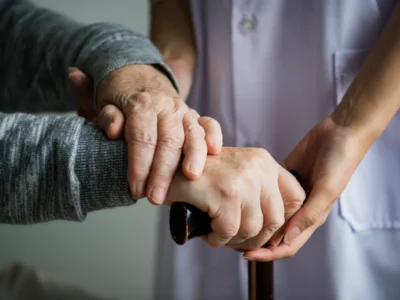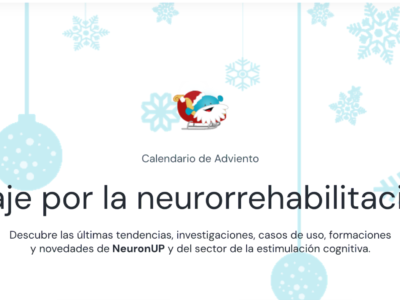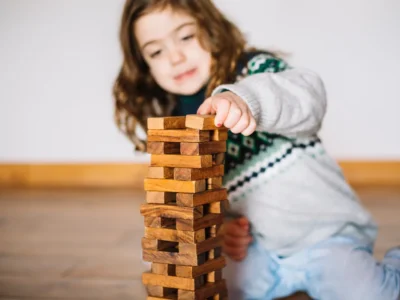Zeltia Veiga Roca, psychologist and neuropsychologist at ZV Psychology | Neuropsychology, presents how they apply neuropsychological rehabilitation and cognitive stimulation with the help of NeuronUP, including real examples that demonstrate the benefits in the cognitive recovery of her patients.
What is ZV Psychology | Neuropsychology and how does cognitive rehabilitation work?
ZV Psychology | Neuropsychology is a neuropsychological rehabilitation center in Ourense, operating since 2020. Its main objective is to minimize cognitive and behavioral alterations and reduce the impact on the daily life of the person who has a brain injury, always taking into account continuous interaction with the family.
At ZV Psychology | Neuropsychology we want to be at the forefront of neuropsychological rehabilitation because we are aware of the importance that cognitive stimulation has for the person as a means for an improvement in neuronal performance to be real and effective.
We care about the person, we care about what happens to them. We want all of them to feel welcomed and understood. Therefore we consider that our work toward the patient and our commitment to up-to-date training are key to this end.
What does neuropsychological rehabilitation consist of?
The neuropsychological rehabilitation encompasses four types of intervention:
- Cognitive rehabilitation,
- behavior modification,
- family intervention
- and professional reintegration.
With them, neuropsychologists aim to reduce cognitive and behavioral alterations so that the impact of brain injury is less both in the life of the patient and in that of their family.
An essential part of rehabilitation is cognitive stimulation. To increase its effectiveness, we must design an individualized rehabilitation program, adjusting to the specific characteristics of each case: we must take into account age, educational level, type of injury and each person’s particular needs, thus recording the individual’s cognitive reserve (CR) in the CR questionnaire.
The cognitive reserve is a active and dynamic process acquired throughout life by which neurological damage is compensated using the processing resources the person has available. The greater the CR, the greater the neuronal optimization, so for us it is of utmost importance to take it into account in order to predict and adjust our work plan adapted to the person.
Given the constraints that are usually both economic and related to travel, in-person training is often insufficient, so being able to continue rehabilitation at home becomes a very necessary option. Hence the origin of telerehabilitation (TRHB), which allows the neuropsychologist to make a broader and more specific intervention plan.
Intervention protocol in neuropsychological rehabilitation at ZV Psychology | Neuropsychology
At ZV Psychology | Neuropsychology, we establish a detailed intervention protocol, which consists of several parts, and with which we seek to ensure effective results:
1. Initial Press Conference
First, an initial Press Conference in which your clinical history is collected. That is, where your identification data, personal history, medical and psychopathological history, and family history are recorded. In addition to behavioral and emotional aspects, reports and an assessment if appropriate.
2. Detection and assessment of deficits
Once we’ve identified the key areas to work on, we define where greater emphasis should be placed and what needs to be reinforced; also considering whether there is a need to establish substitution strategies or introduce compensatory mechanisms.
3. In-person sessions
After all considerations, we propose the in-person schedule, which will be weekly. Each session adopts a dual approach in which both digital activities and NeuronUP paper exercises are worked on. This allows us to continue observing so we can adapt the sessions again if necessary.
4. Telerehabilitation
Thanks to NeuronUP2GO, our users continue their cognitive rehabilitation at home with 15-20 minute sessions a day.
NeuronUP2GO is a fundamental tool because it offers a precise and exhaustive record of each exercise they do. In this way we can anticipate a possible deterioration because the data collected in the “Digital results” section are able to capture changes even if they are subtle.
5. Continuous follow-up
Every seven to ten days, we carry out the individualized follow-up of each patient with NeuronUP2GO, analyzing their progress in the graphs.
Recently, NeuronUP generates reports very easily for us professionals not only by incorporating the progress graph, but also the development by cognitive functions. In this way, we also maintain contact with the family and can discuss the patient’s progress.
This creates two-way feedback because they can resolve doubts and at the same time we can infer how the patient is progressing outside the clinic.
For their part, having this two-way relationship also has a direct positive impact for each user, since it generates greater adherence to the treatment.
Personalized cognitive stimulation program for a person with logopenic Alzheimer’s disease
For example, for a person with logopenic AD, we will place more emphasis on the NeuronUP exercises focused on language. That is, we add sessions where the main theme is language.
For example:
- Matching Adjectives to Images, a vocabulary activity where you have to match each adjective to the image that represents that characteristic.
- Making Words, an exercise aimed at working memory and vocabulary, in which you have to form words by ordering fragments, syllables, or single letters.
- Form words by combining letters, cards used to work working memory, flexibility and vocabulary and that consist of forming words by combining different letters and syllables.
- Find a word by its definition, another vocabulary activity that consists of figuring out the words that correspond to the given definitions.
Cognitive stimulation for a person with dementia
If the dementia is still in its early stages, we will try to get ahead of the course of deterioration by strengthening selective attention, episodic, semantic, procedural memory and processing speed.
In cases of moderate dementia, we consider it beneficial to reinforce selective attention, working memory and declarative memory daily.
Personalized cognitive stimulation program for a person with acquired brain injury (ABI)
How do we work on cognitive stimulation for people with mild neurologic-cognitive impairment?
This proposal is intended for people who have a mild neurologic-cognitive impairment and for those who want to use NeuronUP as cognitive training to stay in shape.
In this case it should be taken into account that, in any of the programs, there is a large variability to be able to exercise all cognitive areas.
At ZV Psychology | Neuropsychology, we place great emphasis on:
- Processing speed, with activities like Stop the Ball, where the person has to calculate when a ball passes a specific point.
- Semantic memory, with exercises such as:
- Home Delivery, to memorize the order in which buildings light up and repeat it in reverse;
- and Press Conference, where they have to remember the order in which several journalists speak and reproduce it.
- Semantic memory, with exercises such as Order Alphabetically.
- Executive functions, with different activities such as:
- Hit the Target Right, in which you have to find different ways to achieve a given score on a target;
- Forming numbers, in which you have to combine numbers in different ways as requested;
- Moving cubes, with which you have to calculate how several cubes would look after changing their positions;
- and Categories Against Time, in which you have to select the elements that belong to a given category as quickly as possible.
How do we work on cognitive stimulation for people with moderate brain injury?
In the case of people with moderate brain injury, daily exercises of selective attention and executive functions will predominate, with an emphasis on working memory and planning.
For example:
- Bottle Caps, an activity where the person must order the sequence of letters or numbers.
- Linked operations, cards with which users must carry out a series of operations in sequence.
- Image Sequence Recognition, cards that require memorizing a series of images in order and later recognizing that sequence.
- Order steps of activities, in its text and images version, to put in order different steps to carry out a specific activity.
- Balance the Bags, a game to balance the weight of the bags on both arms.
- Additions, an activity to perform additions.
- Subtractions, an activity to perform subtractions.
- Color Lottery, an exercise where you must memorize the color of the balls in the drum to then determine which one was drawn.
How do we work on cognitive stimulation for people with severe brain injury?
Finally, to work on the cognitive rehabilitation of people with severe brain injury, we will try to have the person do daily selective and sustained attention exercises as a fixed daily part.
In NeuronUP, these exercises can be:
- Counting and Selecting, cards in which you have to indicate the number of objects shown.
- Explore and Find, a game that consists of selecting several elements from a group.
- Search for consecutive stimuli, cards in which users must search among a set of stimuli for the given cue.
- Repeated words, cards with which you have to mark the words that appear repeated.
- Copy Letter Matrixes, an activity that consists of copying incomplete matrices by looking at a model matrix.
- Organize the Bookcase, a game to copy the position of the objects from the model.

Subscribe
to our
Newsletter
Real success stories at ZV Psychology | Neuropsychology thanks to NeuronUP
Below we present four similar and recent cases we have treated at the ZV Psychology | Neuropsychology center. All of them are cases of dementia with early–moderate development where symptoms are evident.
To better analyze these cases in this article, we have considered 3 variables:
- diagnosis,
- cognitive reserve (CR)
- and MoCa result.
In the first graphs we compare general performance and memory, while in the second graphs, we will compare attention and language.
Success case 1: Woman with typical Alzheimer’s disease
A 72-year-old woman diagnosed two years ago with typical Alzheimer’s disease. She has been attending ZV Psychology | Neuropsychology weekly for 12 months to work with NeuronUP in her cognitive rehabilitation process. After the initial Press Conference, we established her cognitive reserve at 10, that is, in a mid-high range. In addition, the MoCa score is 11/30.
If you liked this article about how ZV Psychology | Neuropsychology uses NeuronUP for the cognitive rehabilitation of brain injury and dementias, you will surely be interested in these NeuronUP articles:
“This article has been translated. Link to the original article in Spanish:”
Cómo ZV Psicología l Neuropsicología utiliza NeuronUP para la rehabilitación cognitiva de daño cerebral y demencias







 Effects of chemotherapy on the brain: Chemobrain
Effects of chemotherapy on the brain: Chemobrain
Leave a Reply